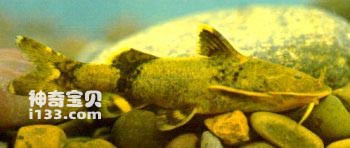Euchiloglanis (Euchiloglanis spp.) belongs to the order Euchiformes, the family Euchiloglanis, and the genus Euchiloglanis. Commonly known as: stone crawler, bluestone crawler, yellow stone crawler, rocket fish.
The body is flat, with a large head and a small tail, the head is particularly flat, the dorsal fin is raised in front of the starting point, and the back of the body is flattened laterally. The mouth is wide, depressed, and slightly curved. The upper and lower jaws have fine teeth arranged in a band-like manner and distributed throughout the oral cavity. The lips are thick, fleshy, have many papillae and wrinkles, and are slightly sucker-shaped. There must be 4 pairs, and the corners of the mouth must be the thickest. The gill openings are small and located above the base of the pectoral fins. The eyes are small, located on the top of the head and covered with skin. The dorsal fin is underdeveloped, the adipose fin is long and low, and the pectoral fin is large and broad, round, sucker-shaped, and fleshy. The first soft rays of the pectoral and pelvic fins are very developed and become very fat. The anal fin is short and small, the tail fin is truncated; the body has no scales. The back and tail are dark brown, and the belly is white.

It is a flowing bottom-dwelling fish with a very narrow range of activities and no migration. It often inhabits the gravelly rapids of mountain streams and rivers. It attaches its flat abdomen and the ventral surface of the thorax to the rocks and moves in a crawling manner. It is an omnivorous fish that mainly eats animal food. Its food mainly consists of aquatic insects and their larvae, such as mayfly larvae, dragonfly larvae, stoneflies, caddis flies, water earthworms, etc., followed by fragments of aquatic plants and organic decay. . The female's ovary and the male's testis each have only one, and they are very small. The spawning period is generally from September to October. Eggs are mostly laid in crevices between rocks in fast-flowing rivers. Fertilized eggs adhere to stones and sand. The difference in appearance between male and female individuals is that males in the non-reproductive period have genital papillae behind the anus, while females in the reproductive period have a higher protruding abdomen.
There are two types of stone crawlers: the distance from the start of the pelvic fin to the start of the anal fin in E. davidi is greater than the distance to the lower corner of the gill opening. The whisker-like extension of the maxillary palps is shorter, only reaching the gill opening, and the pectoral fin is longer. , reaching or near the origin of the pelvic fin. It is distributed in the upper reaches of Qingyi River in Sichuan. The distance from the starting point of the pelvic fin to the starting point of the anal fin of E. kishinouyei is less than the distance to the lower corner of the gill opening. The whisker-like extension of the maxillary palps is longer and exceeds the gill opening. The pectoral fin is shorter and significantly shorter than the starting point of the pelvic fin. It is distributed in the Jinsha River system of Qinghai, Sichuan, Yunnan, and Tibet.
Individuals are generally not too large. Common individuals are 140-170 mm long, and it is said that the maximum length is about 1 kg. There is a lot of natural production and it is easy to catch. Its meat is delicious and contains a lot of fat, no less than that of the longnose catfish. It is the main economic fish in the production area, especially in the Minjiang area of Sichuan, where it is regarded as a precious fish.
animal tags:
We created this article in conjunction with AI technology, then made sure it was fact-checked and edited by a Animals Top editor.